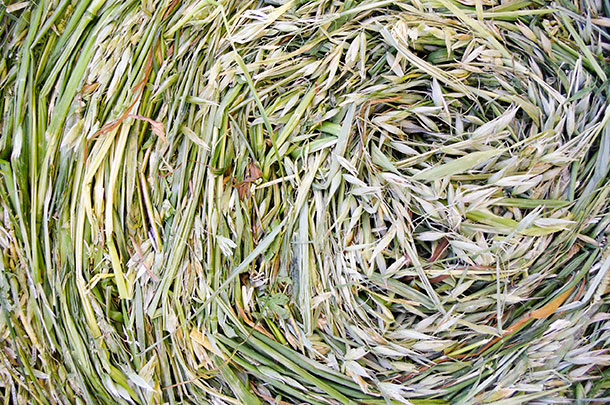Toxic bacterial growth in under-fermented baleage is something every producer should take into consideration. Under-fermented baleage is at high risk for producing the toxin botulinum (which causes botulism). This can occur when the pH of the bales does not drop below 4.5 – the benchmark for clostridia formation. (A must-read on the entire process is a recent university trial on best management practices for round bale silage by W.L. Shockey, et al, published in the May 2014 Journal Of The National Association Of County Agriculture Agents.)
Guessing the moisture content of baleage is a gamble that many producers have played: Bale it too wet or bale it too mature and the feed might not ferment properly. Of the two alternatives, poor fermentation of a high-moisture bale or any type of silage material can lead to a deadly situation caused by the bacteria Clostridium botulinum, type B. Carcasses (that snake, deer or groundhog you know you shredded in the mower) in fed forages are also a source of another botulinum toxin known as type C.
In all, there are seven types of botulinum toxins. Types A, B, E and F can infect humans. Types C and D are found in poultry, wild birds, mink and their excrements. Type E is a fishy thing. In instances where an outbreak of a known strain of botulism is suspected, an antiserum can be used for treatment, but oftentimes it’s just too late. Make no mistake – even miniscule amounts of the botulinum toxin can decimate a barn full of livestock. It is not uncommon to read about situations where hundreds of cattle and horses have died within hours of eating contaminated feed. In fact, if you have ever heard the rumor that haylage or baleage is not safe to feed to horses, it’s probably because of this reason. Horses are much more sensitive to botulinum toxins that other livestock.
Take guessing out of the equation
For about $300, you can use a moisture tester designed for windrow testing. Ideal fermentation conditions occur at 40 to 50 percent moisture. However, this will vary by the maturity and composition of the forage. What can I say? It’s still a bit of a guessing game on the fermentation process when the forage is not at that ideal maturity stage to make a perfect high-moisture bale. When in doubt, call about. Firsthand knowledge is valuable insurance when it comes to knowing just when to bale for optimal fermentation.
Excluding oxygen is a must, so to avoid any distress after baling, go around the bale four to six complete revolutions with bale wrap.
If you’re still not sure whether Clostridium botulinum has formed, you can test before you feed, but it gets a little more expensive. A better-safe-than-sorry bale probe ($200) that augers out a representative forage sample so that it can be tested with a silage moisture meter ($300) is worth the investment, compared with the cost if you are wrong. You will need litmus paper or a portable pH meter to determine if the bale is above 4.5 pH. Make sure to take the entire core from one bale and mix it up in a bucket with equal parts of distilled water. Or if you have the time, you can send a sample from each bale to a forage analysis laboratory for testing.
This is the bottom line: Do not feed any bales above 6.0 pH. Anything above 5.5 pH should be evaluated closely for mold, a rotten smell or an ammonia odor. These are all signs of clostridia or listeria formation, and they can occur in any type of high-moisture feed that did not undergo proper fermentation. The National Botulism Reference Laboratory at the New Bolton Center in Pennsylvania “provides testing for samples from multiple animal species, including equine, bovine, avian and canine, as well as suspected feedstuffs and forages.”
Oh, and one last thing to worry about – OK, well, two – don’t overlook the more common livestock deaths from baleage – legume bloat and high-potassium-induced grass tetany. FG
Melissa Bravo is a certified crop adviser and herd health specialist with Meadow Lake Farm Consulting. Email Melissa Bravo.
PHOTO: When the pH of a bale does not drop below 4.5, botulinum toxins can form. Subsequent testing is the only way to be sure. Photo by Melissa Bravo.









